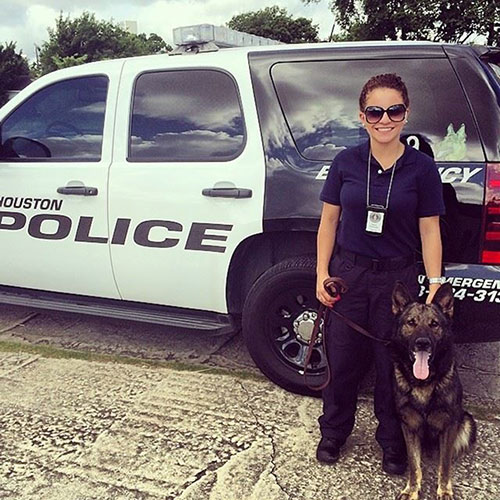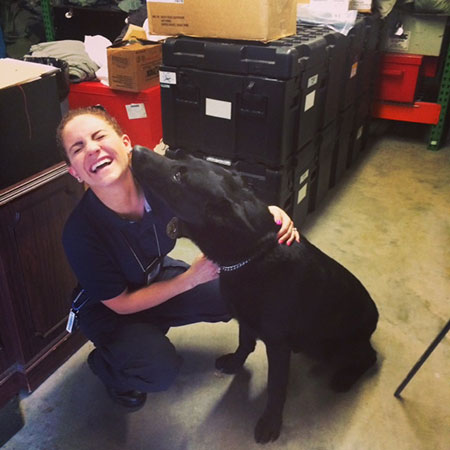Intern Takes Bite Out Of Crime With Houston’s K-9 Unit
Sept. 11, 2014
SHSU Media Contact: Beth Kuhles
 |
| Andrea Marmorato and Hero prepare to hit the streets on a typical day during her summer internship with the Hoston Police Department's K-9 Unit. —Submitted photos |
Senior criminal justice major Andrea Marmorato set her sights on law enforcement at an early age and took action to make her dreams a reality.
“I graduated from the Houston Citizen Academy two years ago,” Marmorato said. “We got to see SWAT, Mounted Patrol, and the helicopter unit called FOX, but the K-9 Unit Program, that was my favorite.”
During the summer, Marmorato worked side-by-side with K-9 units during training and actual operations in the field, sometimes serving as the “decoy” for the dogs to find. She also donned the bite sleeve and took a hit from the powerful jaws, but never once experienced fear.
“I can’t say I was ever scared,” Marmorato said. “I trusted my officers and the dogs that they would not put me in jeopardy.”
Sgt. Andy Porras said the K-9 Unit Program is a good place for interns to train because they get to work throughout the city, and they get to ride along with officers on calls.
“Coming to K-9, they get a more well-rounded experience,” Porras said. “They see what we do with the dogs in training, and they can ride with the officers and see how we interact with other departments. We are a support unit, often called in when a suspect runs from officers, like during the burglary of a building. K-9 provides the feeling of what is involved in a police officer’s work throughout the entire city.”
Marmorato shadowed K-9 officers during all shifts, watching newly paired teams train and going on calls to help track suspects in the field–often in wooded areas.
“Most of the calls were burglary and theft where the suspects run,” Marmorato said. “Police set up a perimeter and call up K-9 and FOX (the helicopter). If the suspect is there, we will find them. It never ceases to amaze me. A suspect may have 10 officers with weapons pointed at them and they won’t surrender. But the moment they see the dog, they give up.”
There are 10 to 15 K-9 teams at the Houston Police Department, trained in various specialties, including drugs, bombs, SWAT and patrol. The department mainly uses German Shepherds and Belgium Malinois, each which requires 500 hours of training.
Marmorato witnessed two new teams in training, which included obedience, obstacles, shooting and tracking.
“A lot of them are puppies, and they just want to play,” Marmorato said. “They are great dogs at home. But when they get to work, they know what their job is. If there is a suspect, they will find them.”
 |
Gunner, with the K-9 Unit, shows his affection for intern Marmorato. |
Marmorato got to play the suspect in several scenarios. At the old police property room—a large warehouse filled with cages and dark corners—she hid in the dark in the expansive venue, back pressed against the wall under a piece of plywood. In the heat, she began to sweat, a scent the dog can find in closed buildings.
After a sweep of the building, the dog came to the area, barking and pawing at the cage, indicating a find.
“They searched the whole building,” Marmorato said. “Where there is one suspect, there could be two; where there is two, it might be three.”
Because of the open air and winds, outside the dogs track using the scent of broken grass and vegetation. Dogs frequently will throw their nose in the air to pick up the trail and then put their head to the ground to follow it.
During training, the reward for the dog is to let them bite the decoy wearing the bite sleeve. Marmorato took one of those bites.
“Other than the dog tugging, you don’t feel anything else,” she said.
On several calls, she also got to traipse through the woods in pursuit of suspects.
“I got poison ivy twice,” Marmorato said. “I found out my boots were not waterproof. I wore long tactical pants, which were really hot, but after walking through tall grass, I was thankful for the pants that made me sweat. I didn’t know if there were snakes and spiders out there. I’m kind of a girl that way.”
Porras said that Marmorato has what it takes to be a good police officer.
He said Houston officers can only join the K-9 unit, or other specialties after like homicide or SWAT, after five years on the streets.
“She’s very intelligent, and she has good sense in evaluating people,” Porras said. “She is a well-rounded individual, and she would make an excellent police officer.”
Marmorato said she first plans to return to school to pursue her master’s degree.
“It was a pretty amazing experience; I learned patience,” Marmorato said. “But to hear the calls coming in, it made me pretty emotional, like with the domestic violence calls. They get to you. There is not much you can do, even after you are called to the house three to four times and they are still getting beaten. You can’t make the victim leave.”
Another lesson she learned, one she hopes to share with the public, regarded the public’s tendency to fail to yield to police officers with sirens. There were days when they missed suspects because of the delays.
“When you hear lights and siren, pull out of the way,” Marmorato said. “Don’t slam on your brakes; that causes accidents. It’s hard to get to a call safely when people won’t get out of the way. People’s lives are in danger.”
- END -
This page maintained by SHSU's Communications Office
Associate Director: Julia May
Manager: Jennifer Gauntt
Located in the 115 Administration Building
Telephone: 936.294.1836; Fax: 936.294.1834
Please send comments, corrections, news tips to Today@Sam.edu.

 SamWeb
SamWeb My Sam
My Sam E-mail
E-mail

